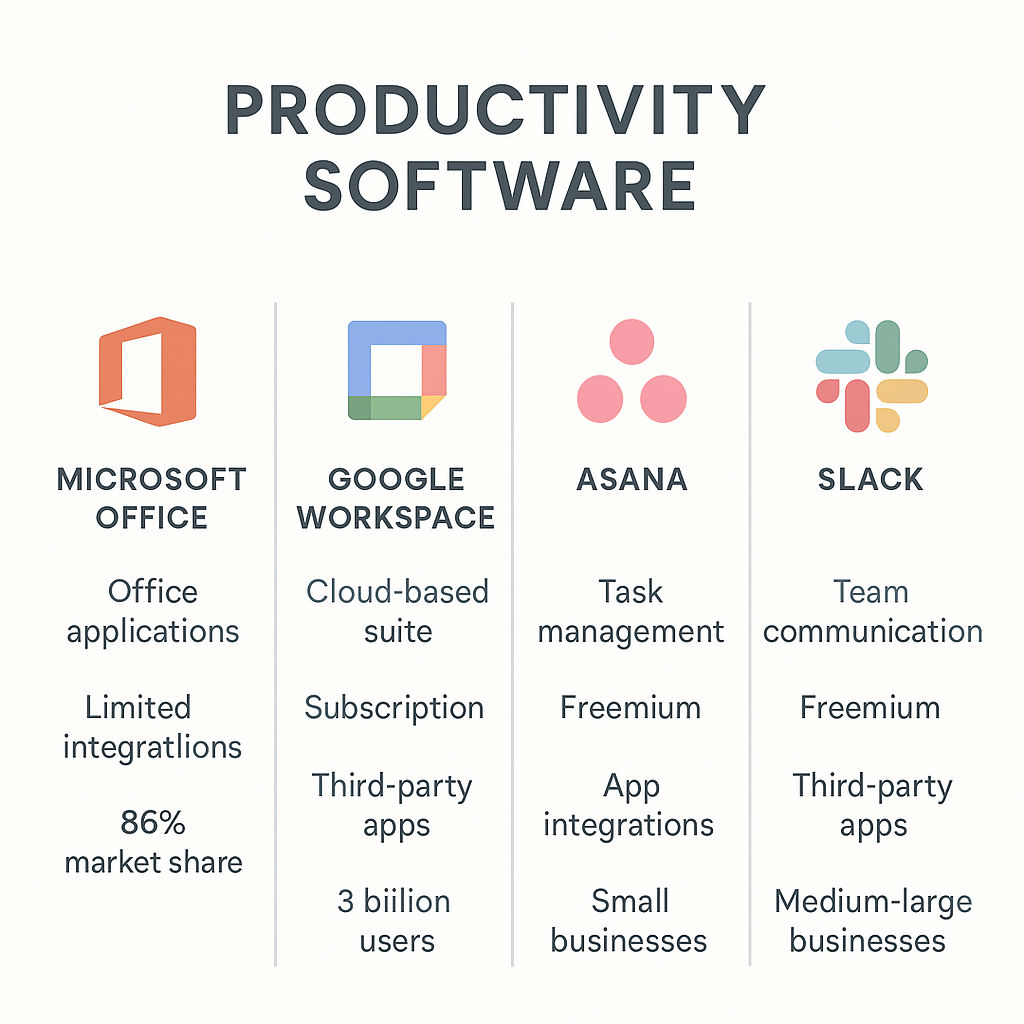
Productivity software has revolutionized modern work environments by streamlining tasks, enhancing collaboration, and improving efficiency across organizations. From traditional word processors to AI-powered platforms, these tools have evolved significantly. Understanding their capabilities and potential is crucial for businesses seeking to optimize operations and remain competitive in today’s digital landscape.
Good to know
Businesses can achieve up to 25% improvement in operational efficiency and significant cost reductions through strategic implementation of productivity software, particularly in areas like task management, communication streamlining, and data analysis capabilities.
Understanding Productivity Software
Productivity software represents a fundamental category of applications designed to help individuals and organizations create, manage, and process information more efficiently. Originally termed “office productivity software,” these tools emerged in the 1980s when personal computers began revolutionizing traditional office environments that relied heavily on typewriters, paper filing systems, and handwritten ledgers. Today, the scope extends well beyond document creation to include intelligent financial and operational solutions such as sales commission software, which help align employee motivation with company performance goals and provide greater visibility into compensation management processes.
Origins and Evolution of Productivity Tools
The concept of productivity software gained prominence with the introduction of office suites in the early 1980s. MicroPro’s WordStar suite, comprising WordStar word processor, CalcStar spreadsheet, and DataStar database software, marked the beginning of integrated productivity solutions. These early tools demonstrated remarkable efficiency gains compared to pre-digital office methods, fundamentally transforming workplace operations.
Today, approximately 78% of “middle-skill” occupations in the United States require proficiency in productivity software, highlighting its critical importance in modern employment. The scope has expanded far beyond traditional document creation to encompass comprehensive business management solutions.
Core Types and Modern Applications
Traditional productivity software includes word processors, spreadsheets, presentation tools, and database management systems. However, modern productivity tools have evolved to include project management applications, collaborative platforms, and mobile-optimized solutions that enable remote work capabilities.
Collaborative and Cloud-Based Solutions
Contemporary productivity software emphasizes real-time collaboration and cloud accessibility. Microsoft Office 365 and Google Workspace exemplify this evolution, offering integrated suites that support simultaneous editing, instant communication, and seamless file sharing across devices. These platforms have transformed productivity software from standalone applications into comprehensive digital workspaces that facilitate team coordination and project management across geographical boundaries.

Popular Productivity Software: A Comparative Overview
The contemporary productivity software landscape is dominated by several key players, each offering distinct advantages for different organizational needs. Understanding these platforms’ capabilities helps businesses make informed decisions about their digital infrastructure investments.
Market Leaders: Microsoft and Google
Microsoft 365 maintains its position as a comprehensive productivity suite, offering Word, Excel, PowerPoint, and Teams within a unified ecosystem. Current pricing starts at $6 per user monthly for basic plans, scaling to $22 monthly for enterprise features. The platform excels in advanced document editing, robust offline capabilities, and extensive third-party integrations through its Microsoft Graph API.
Google Workspace captures over 50% of the productivity software market, according to recent data, with pricing beginning at $6 per user monthly. Its cloud-native architecture enables real-time collaboration across Docs, Sheets, and Slides, while Gmail integration streamlines communication workflows. The platform’s strength lies in its intuitive interface and seamless cross-device synchronization.
Specialized Collaboration Tools
Asana focuses specifically on project management and task coordination. Free plans accommodate teams up to 15 members, while premium features cost $10.99 per user monthly. The platform offers sophisticated project tracking, custom workflows, and timeline visualization tools that integrate effectively with both Microsoft and Google ecosystems.
Slack revolutionizes team communication through organized channels and direct messaging. Pricing ranges from free basic plans to $12.50 per user monthly for advanced features. The platform supports over 2,000 app integrations, enabling seamless connectivity with existing business tools and workflows.
Integration and Suitability Considerations
Small businesses often benefit from Google Workspace’s simplicity and cost-effectiveness, while enterprises typically require Microsoft 365’s advanced security and compliance features. Asana suits project-heavy organizations, whereas Slack optimizes communication-intensive environments. Successful implementation depends on evaluating specific workflow requirements, budget constraints, and existing technology infrastructure.

How Productivity Software Can Save Businesses Money
Beyond selecting the right productivity software, understanding how these tools translate into tangible financial benefits is crucial for business decision-makers. The strategic implementation of productivity solutions creates measurable cost reductions across multiple operational areas, making them essential investments rather than mere expenses.
Direct Cost Reduction Through Enhanced Task Management
Effective task management software delivers immediate cost savings by eliminating redundant processes and reducing project completion times. Studies indicate that businesses implementing comprehensive task management systems experience up to 25% reduction in project costs through improved resource allocation and deadline adherence. Companies utilizing platforms like monday.com report average time savings of 4.5 hours per employee weekly, translating to substantial labor cost reductions when calculated across entire organizations.
The elimination of manual tracking systems further reduces administrative overhead. Traditional paper-based or spreadsheet management requires dedicated personnel hours for updates and maintenance, costs that vanish with automated productivity solutions.
Communication Efficiency and Operational Savings
Enhanced communication tools significantly reduce the financial burden of information silos and miscommunication errors. Research demonstrates that poor communication costs businesses an average of $62.4 million annually for companies with 100,000 employees. Integrated communication platforms streamline information flow, reducing email volume by up to 48% and cutting meeting times by an average of 35%.
Remote work capabilities enabled by productivity software generate additional savings through reduced office space requirements and lower overhead costs. Organizations report facility cost reductions of 15-30% when implementing comprehensive remote work productivity solutions.
Data-Driven Decision Making and Scalability Benefits
Advanced data analysis capabilities within productivity software enable businesses to identify cost-saving opportunities previously hidden in operational complexity. Real-time analytics prevent costly mistakes and optimize resource allocation, with companies reporting 20-40% improvements in budget accuracy and forecasting precision.
Scalability features ensure that productivity investments grow with business needs, eliminating the recurring costs of system replacements and reducing long-term technology expenditures significantly.

The Future of Productivity Software
The landscape of productivity software is rapidly evolving, driven by technological advances that promise to reshape how we work and collaborate. As businesses continue to adapt to hybrid work environments and seek greater efficiency, the future of productivity tools appears increasingly sophisticated and interconnected.
AI-Powered Revolution in Workplace Efficiency
Artificial intelligence stands at the forefront of productivity innovation, transforming traditional software into intelligent assistants. AI-powered tools now offer predictive text, automated scheduling, and smart data analysis capabilities that learn from user behavior patterns. Microsoft’s Copilot and Google’s Workspace AI features exemplify this shift, enabling users to generate content, summarize meetings, and extract insights from complex datasets with unprecedented speed. Industry analysts predict that by 2027, over 85% of productivity software will incorporate some form of AI functionality, fundamentally changing how teams approach routine tasks.
Seamless Platform Integration and Mobile-First Design
The future emphasizes seamless integration across diverse platforms and devices. Modern productivity solutions are breaking down silos between applications, allowing data to flow effortlessly between project management tools, communication platforms, and analytical software. This interconnected ecosystem enables real-time collaboration regardless of the specific tools team members prefer to use.
Mobile accessibility has become paramount as remote work solidifies its position in business operations. Technology leaders are prioritizing mobile-optimized interfaces that maintain full functionality across smartphones and tablets, ensuring productivity remains uninterrupted regardless of location or device constraints.
Emerging Challenges and Opportunities
Despite promising trends, challenges persist around data security, user privacy, and the digital divide. Organizations must balance innovation with robust cybersecurity measures while ensuring equitable access to advanced productivity tools across all team members.

What to remember about productivity software
The landscape of productivity software continues to evolve rapidly, driven by artificial intelligence integration, mobile accessibility, and cross-platform compatibility. Organizations that strategically implement these tools can achieve significant cost savings while improving operational efficiency. As remote work becomes increasingly prevalent, the demand for collaborative and cloud-based solutions will continue to grow. Future developments will likely focus on seamless automation, enhanced user experience, and deeper integration capabilities, making productivity software an indispensable component of modern business strategy.